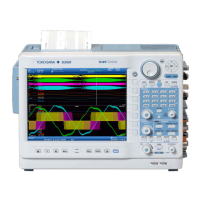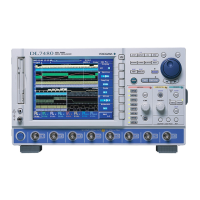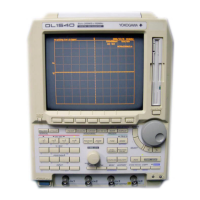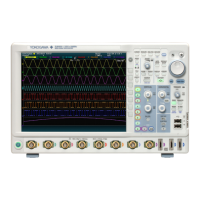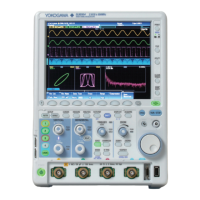2-10
IM DLM6054-01EN
TV Trigger (ENHANCED)
Use this trigger to observe video signals. The trigger supports NTSC (525/60/2), PAL (625/50/2), SDTV
(480/60p), and HDTV broadcasting systems. You can also specify the horizontal sync frequency and
trigger on the video signals of broadcasting systems other than those listed above.
Serial Trigger (ENHANCED)
This is one of the triggers that you can use on serial bus signals. You can use it to capture serial
patterns.
The DL6000/DLM6000 synchronizes to the selected clock signal and detects a specified serial data
pattern. You can specify up to 128 bits for the serial data pattern used for triggering. You can set the
CS signal, which controls the period over which the data source is checked, and the latch source,
which specifies when patterns are compared.
For information about I
2
C, CAN, LIN, SPI, and UART triggering, see the Serial Bus Signal Analysis
Manual, IM DLM6054-51EN.
Event Interval Trigger (ENHANCED)
You can use this feature to trigger by treating the occurrences of the trigger conditions, except for Edge
OR and TV triggers, as events. You can make the DL6000/DLM6000 trigger when the interval between
two events (either the same or different) meets the specified time conditions. The time conditions that
you can set are the same as those that you can set for the Width trigger.
Event Cycle
The DL6000/DLM6000 triggers when the specified relationship between the event interval and the
reference times is established.
Event
More than
t
1
t2
t3
t1 < T1 t2 > T1 t3 < T1
Between
Out of Range
Trigger
Time out
Reference time: T1
Event
t1
t2 t3
t1 < T1 t2 > T1 t3 < T1
Trigger
Reference time: T1
Trigger
Event
t1
t2
t3
T1 < t1 < T2 T2 < t2 t3 < T1
Trigger
Reference times: T1 and T2
Event
t1
t2
t3
T1 < t1 < T2 T2 < t2 t3 < T1
Trigger
Reference times: T1 and T2
Trigger
Event
t1
t2
t3
Trigger
Reference time: T1
T1
t1 < T1 t2 > T1 t3 < T1
2.3 Triggering

